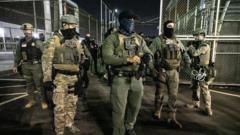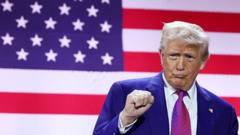In a strategic move towards reinforcing its defense posture, Japan is bolstering its military presence on Okinawa in response to heightened concerns about China's increasing naval power and its own security ties with the U.S.
Japan Strengthens Military Presence Amid Rising Tensions with China and the U.S.

Japan Strengthens Military Presence Amid Rising Tensions with China and the U.S.
As Japan's military capabilities expand, they signal deterrence strategies aimed at both China and U.S. relations.
Japan's Ground Self-Defense Force (GSDF) has taken a significant step in its military evolution, showcasing new ship-slaying missiles stationed on transport trucks at a visible base on Okinawa. This prominent display is part of a broader defense strategy aimed at countering threats from an assertive Chinese navy. Established just a year prior, the Seventh Regiment of the GSDF has made it clear that these armaments serve as a deterrent against potential adversaries.
Colonel Yohei Ito, at the helm of the regiment, explicitly states that the show of force is meant to discourage not only potential enemies but also to send a message to the United States, particularly referencing the criticisms levied by President Trump regarding Japan's dependence on American military support.
The missile installations on Okinawa are part of a larger effort to modernize Japan's defense framework. Japanese officials, currently engaged in tariff negotiations with Washington, are keen on enhancing their security relationships as a central theme of their diplomatic strategy. Tokyo's commitment to increasing defense spending includes potential purchases of energy, computer chips, and military equipment, hoping this will bolster its bargaining position with the U.S.
The efforts undertaken by Japan's military reflect a commitment to fortifying national security amid complex geopolitical dynamics and emphasize the importance of self-sufficiency in defense capabilities. The scout-like mobility of the regiment's missiles provides the flexibility needed to respond to regional threats while also demonstrating a more proactive stance in the realm of international security.
Colonel Yohei Ito, at the helm of the regiment, explicitly states that the show of force is meant to discourage not only potential enemies but also to send a message to the United States, particularly referencing the criticisms levied by President Trump regarding Japan's dependence on American military support.
The missile installations on Okinawa are part of a larger effort to modernize Japan's defense framework. Japanese officials, currently engaged in tariff negotiations with Washington, are keen on enhancing their security relationships as a central theme of their diplomatic strategy. Tokyo's commitment to increasing defense spending includes potential purchases of energy, computer chips, and military equipment, hoping this will bolster its bargaining position with the U.S.
The efforts undertaken by Japan's military reflect a commitment to fortifying national security amid complex geopolitical dynamics and emphasize the importance of self-sufficiency in defense capabilities. The scout-like mobility of the regiment's missiles provides the flexibility needed to respond to regional threats while also demonstrating a more proactive stance in the realm of international security.




















